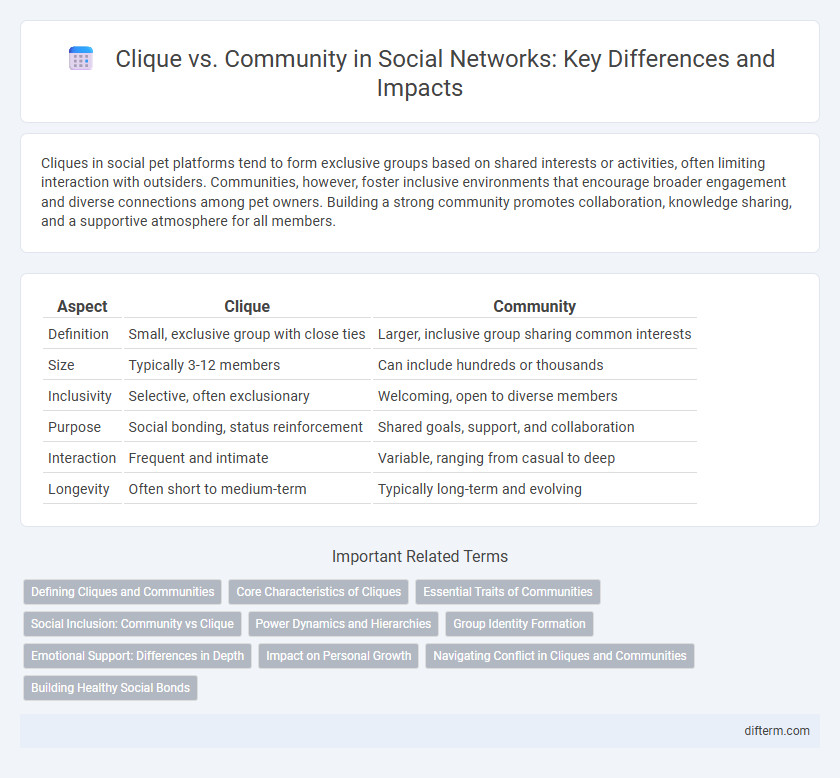Cliques in social pet platforms tend to form exclusive groups based on shared interests or activities, often limiting interaction with outsiders. Communities, however, foster inclusive environments that encourage broader engagement and diverse connections among pet owners. Building a strong community promotes collaboration, knowledge sharing, and a supportive atmosphere for all members.
Table of Comparison
| Aspect | Clique | Community |
|---|---|---|
| Definition | Small, exclusive group with close ties | Larger, inclusive group sharing common interests |
| Size | Typically 3-12 members | Can include hundreds or thousands |
| Inclusivity | Selective, often exclusionary | Welcoming, open to diverse members |
| Purpose | Social bonding, status reinforcement | Shared goals, support, and collaboration |
| Interaction | Frequent and intimate | Variable, ranging from casual to deep |
| Longevity | Often short to medium-term | Typically long-term and evolving |
Defining Cliques and Communities
Cliques are small, tightly-knit social groups characterized by strong, exclusive bonds and frequent interactions among members, often leading to an inward-focused dynamic. Communities, in contrast, encompass broader networks with diverse individuals connected by common interests, goals, or locations, promoting inclusivity and shared identities. The distinction lies in cliques' exclusivity versus communities' openness, influencing social cohesion and interaction patterns.
Core Characteristics of Cliques
Cliques are defined by exclusivity, strong emotional bonds, and a limited membership that often enforces conformity and loyalty among its members. These groups prioritize homogeneity, frequently leading to social hierarchies and exclusion of outsiders. Unlike broader communities, cliques focus on intimate, intense relationships that reinforce group identity and social status.
Essential Traits of Communities
Communities are defined by shared values, mutual support, and a sense of belonging that fosters long-term connections and collective growth. Unlike cliques, which often emphasize exclusivity and social hierarchy, communities promote inclusivity, open communication, and collaboration among diverse members. Essential traits of communities include trust, shared goals, active participation, and emotional investment, all contributing to a sustainable social ecosystem.
Social Inclusion: Community vs Clique
Social inclusion thrives in communities where diverse individuals share common goals and support each other's growth, contrasting sharply with cliques that often exclude outsiders and limit social interaction. Communities foster belonging and collective identity through inclusivity, encouraging participation across varied backgrounds. Cliques, by definition, create exclusivity and social barriers, hindering broader social cohesion and equitable inclusion.
Power Dynamics and Hierarchies
Cliques concentrate power within a small, exclusive group, reinforcing rigid hierarchies that often marginalize outsiders and limit diverse participation. Communities distribute influence more broadly, fostering collaborative decision-making and egalitarian structures that empower members. Understanding these dynamics is crucial for promoting inclusivity and reducing social stratification in group settings.
Group Identity Formation
Cliques form through selective social exclusion, fostering strong but limited group identity among members with shared interests or traits. In contrast, communities develop broader, inclusive group identities based on shared values, goals, or geographic proximity, promoting collective participation. Group identity formation in cliques is exclusive and homogeneous, whereas communities emphasize diversity and inclusivity within their social bonds.
Emotional Support: Differences in Depth
Cliques often provide limited emotional support due to their selective and exclusive nature, focusing on superficial bonds that may not address deeper personal needs. Communities foster inclusive emotional support networks characterized by empathy, trust, and shared experiences, offering members a stronger sense of belonging and resilience. The depth of emotional support in communities surpasses that of cliques by emphasizing mutual understanding and continuous reinforcement.
Impact on Personal Growth
Cliques often limit personal growth by promoting exclusivity and reinforcing narrow social norms, which can stifle diverse perspectives and self-expression. Communities foster inclusivity and collaboration, encouraging members to explore new ideas and develop empathy through shared experiences. Engaging in a community supports broader social skills and emotional intelligence, enhancing overall personal development.
Navigating Conflict in Cliques and Communities
Navigating conflict in cliques and communities requires understanding their different social dynamics; cliques often involve exclusive relationships with heightened emotional intensity, making conflicts more personal and challenging to resolve. Communities, characterized by broader inclusivity and shared goals, typically benefit from established conflict resolution mechanisms that emphasize open communication and collective problem-solving. Effective conflict management in both settings relies on fostering empathy, active listening, and a commitment to maintaining group cohesion while addressing underlying issues.
Building Healthy Social Bonds
Cliques often limit social interaction to exclusive groups, hindering the development of diverse and supportive relationships. Communities foster inclusive environments that encourage mutual respect, shared goals, and emotional support. Building healthy social bonds thrives in communities that promote open communication and collective well-being.
clique vs community Infographic

 difterm.com
difterm.com